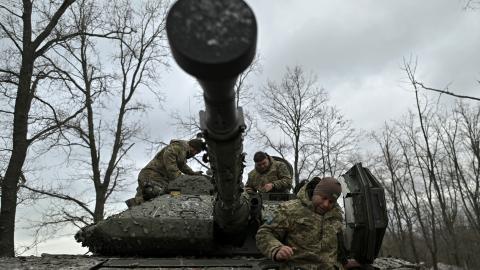The 10th anniversary of the start of Ukraine’s Euromaidan, when thousands of demonstrators set up a protest camp in Kyiv’s central square, was last week.
Ukraine’s economy had been struggling and the Kremlin-backed President Viktor Yanukovych knew something had to be done to create new opportunities. Meanwhile the EU’s Eastern Partnership, the platform used by Brussels to engage with Eastern Europe, was keen to deepen relations with the countries of east, especially Ukraine. This led to a proposed political association and free trade agreement between the EU and Kyiv.
Of course, the Kremlin did not like the thought of Ukraine getting closer to Brussels and started to pressure Yanukovych into not signing the agreement. When he bowed to Russia’s wishes, Ukrainians gathered in Maidan Nazalezhnosti (Independence Square) in Kyiv on Nov. 21, 2013, and the Euromaidan was born.
It is worth remembering what happened in the months and years following the Euromaidan because it led to the terrible situation today in Ukraine. Eventually, months of street demonstrations from late 2013 to early 2014 led to Yanukovych’s removal from office. He fled to Russia, where he remains. Russia responded by sending troops, wearing uniforms with no insignia, into Ukraine’s Crimea Peninsula under the pretext of “protecting Russian people.” This led to Russia’s eventual annexation of Crimea. The annexation cut Ukraine’s coastline in half and cost it about 7 percent of its sovereign territory.
In addition to the exploits in Crimea, Moscow stoked sectarian divisions in eastern Ukraine. Backed, armed, and trained by Russia, de facto separatist leaders in eastern Ukraine declared the so-called Lugansk People’s Republic and the Donetsk People’s Republic. Before long, Russian officials, troops, and military hardware flooded into the region. At the time, US President Barack Obama and other European leaders urged the Ukrainians not to fight, but to wait for diplomacy to resolve the crisis. Unsurprisingly, this never happened — an important lesson for Ukrainians in February 2022, when Russia invaded again.
The fighting that began in 2014 left 13,000 dead, 30,000 wounded and 1.4 million people displaced. While these figures pale in comparison to today’s fighting in Ukraine, at the time it was shocking. Two major ceasefire agreements — one in September 2014 and another in February 2015, known as Minsk I and Minsk II — failed. In February 2022, after months of building up military forces along Ukraine’s borders, Russia invaded again. The rest is now history. Today, the largest land war in Europe since the Second World War is playing out between Ukraine and Russia.
Coincidently, the anniversary of another important event in the post-Soviet countries also took place last week — the climax of Georgia’s Rose Revolution in 2003. After fraudulent parliamentary elections, street demonstrations against President Eduard Shevardnadze grew in size throughout November that year.
Shevardnadze was the de facto leader of the Georgian Soviet Socialist Republic in the 1970s and early 1980s. He then became the Soviet foreign minister under Mikhail Gorbachev. In 1995, after the Soviet Union collapsed, he became the president of the newly independent Georgia until he resigned on Nov. 23, 2003, during the Rose Revolution. His departure was an important milestone in Georgia’s history: the end of Soviet-era leaders playing a role in national life and the beginning of Georgia’s path to closer relations with the EU and NATO that continues today. This is why Georgia’s civil society is so supportive of Ukraine in Russia’s war. In fact, thousands of Georgian volunteers have traveled to Ukraine to fight the Russian invasion.
The long-term strategic goal for Russia is ensuring that countries such as Ukraine and Georgia remain out of the transatlantic community and distanced from organizations such as NATO and the EU. Moscow has perfected a formula to make this happen by using military force. Russia’s invasion of Georgia in 2008 and the annexation of Crimea in 2014 slowed down the EU and NATO prospects of both countries because neither organization wants to admit a new member involved in a war with Russia. In the longer run, Russia would also like to see the eventual integration of Ukraine and Georgia into Moscow-backed groups such as the Collective Security Treaty Organization or the Eurasian Economic Union, but for the time being this seems highly unlikely if not impossible. Any sympathy Ukrainians had for Russia has been evaporated by the invasion.
The events that began in Georgia in November 2003, and in Ukraine in November 2013, are a reminder that self-determination is a powerful force. After decades of Russian and Soviet domination, countries such as Ukraine and Georgia want to chart their own path. Considering that Georgia and Ukraine have a history, language, and culture distinctive from Russia’s, this should not be a surprise.
For Ukrainians and Georgians, taking to the streets in a peaceful manner showed that each country has the sovereign ability to determine their own path and to decide with whom they have relations and how and by whom they are governed. No outside actor, in this case Russia, should have a veto on membership or closer relations with organizations such as the EU or NATO.
Street protests against Russian influence in Ukraine in 2013 have transformed into today’s trench warfare against a Russian invader. Ukrainians have sacrificed much to defend their country and there is no indication that the national mood to do so is changing. This week, when marking the 10th anniversary of the events of November 2013, President Volodymyr Zelensky described it as the Ukrainian people’s “first counteroffensive” against Russia saying. “It is up to our generation to determine the direction Ukraine's history will take,” he said.
What Ukraine will look like when it marks the 20th anniversary of the Euromaidan is anyone’s guess. For the sake of the Ukrainian people who have sacrificed so much, let us hope it is a Ukraine that is free, independent, and secure.




















